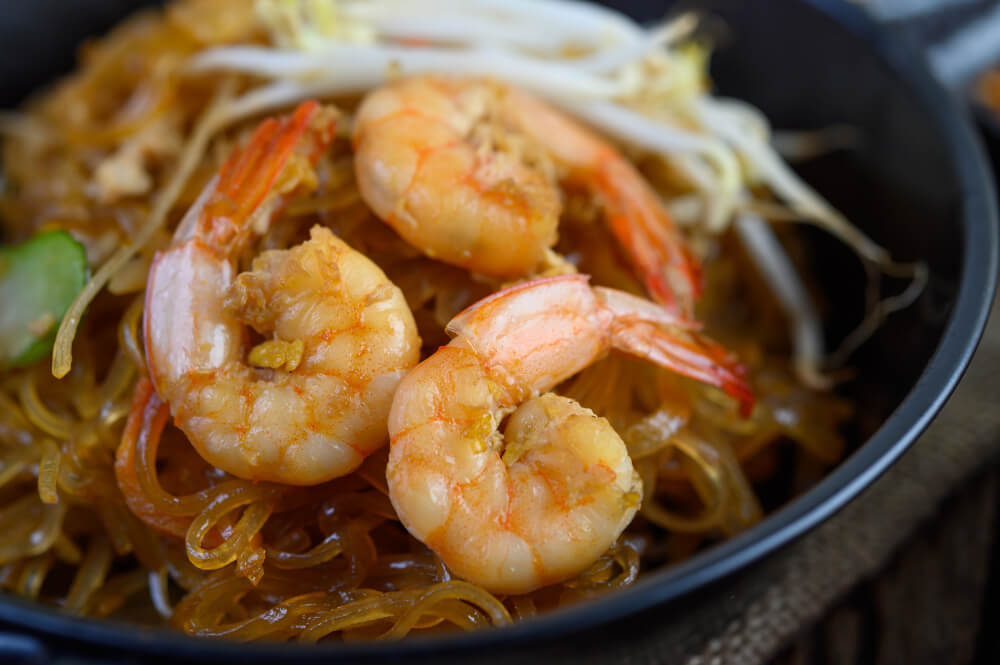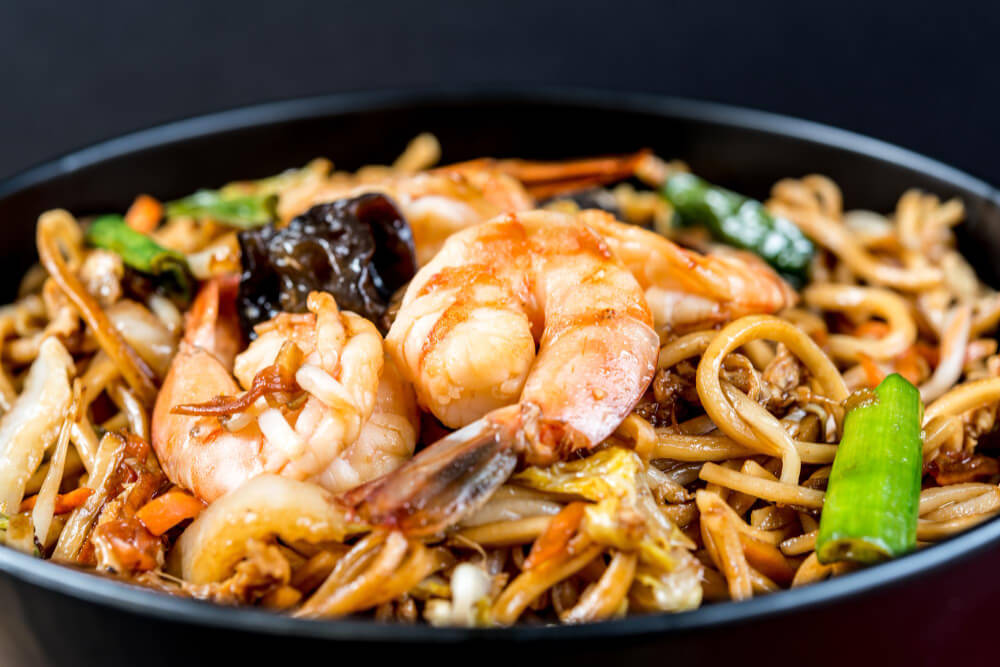Shrimp chow mein is a popular dish that combines tender shrimp, crispy vegetables, and savory noodles. Originating from Chinese cuisine, it has gained popularity worldwide, especially in Chinese-American restaurants.
But what is shrimp chow mein, and how does it differ from dishes like lo mein or chop suey? This guide will explore its history, provide step-by-step preparation instructions, and offer tips for making it healthier. Whether you’re a home cook or just curious, this article has the information you need.
What is Shrimp Chow Mein?
At its core, shrimp chow mein is a stir-fried noodle dish that typically features shrimp, vegetables, and a savory sauce. The word “chow mein” translates to “stir-fried noodles” in Cantonese, showcasing its culinary method.
This dish’s popularity isn’t limited to China—it has become a global phenomenon. Many variations exist, making it versatile for different tastes and dietary preferences. For instance, the classic chow mein noodles are lightly crispy, while some prefer softer, lo mein-style noodles.
Curious about soy sauce varieties that enhance this dish? Here’s a helpful guide on soy sauce types to help you choose the best one for your recipe.
Ingredients for Shrimp Chow Mein
To prepare authentic shrimp chow mein, you’ll need fresh, high-quality ingredients. Each component plays a vital role in achieving its signature taste and texture.
Essential Ingredients
- Shrimp: Fresh or frozen shrimp, deveined and peeled. Large shrimp work best.
- Noodles: Use egg noodles for authenticity, or substitute with rice noodles for gluten-free diets.
- Vegetables: Common choices include shredded cabbage, carrots, bean sprouts, and bell peppers.
- Sauce: A mix of soy sauce, oyster sauce, and sesame oil creates a savory and aromatic base.
Flavor Enhancers
Adding the right balance of seasonings elevates the dish:
- Garlic and ginger for depth of flavor.
- A pinch of sugar or honey to balance the saltiness.
- A dash of chili oil for heat, if desired.
Want to learn more about stir-frying techniques? Check out this science-based guide to stir-frying to perfect your cooking methods.
How to Cook Shrimp Chow Mein
Cooking shrimp chow mein involves three simple steps: preparation, stir-frying, and final assembly. This quick process ensures you get perfectly cooked noodles and shrimp every time.
Preparation
- Shrimp: Rinse, devein, and marinate the shrimp with soy sauce and sesame oil for 15 minutes.
- Noodles: Boil noodles until they’re slightly undercooked (al dente) to prevent overcooking later.
- Vegetables: Chop and prep all veggies in advance for a seamless stir-fry experience.
Stir-Frying
- Heat oil in a wok or large skillet.
- Sear the shrimp until they’re pink, then remove and set aside.
- Stir-fry garlic, ginger, and vegetables until crisp-tender.
- Toss in the noodles, followed by the cooked shrimp.
Final Assembly
Combine all the elements in the wok. Pour in the sauce mixture, ensuring it evenly coats the noodles and shrimp. A quick toss will lock in the flavors and give you a restaurant-style dish at home.
Nutritional Insights of Shrimp Chow Mein

Shrimp chow mein is not only delicious but can also be a balanced meal. Understanding its nutritional profile helps you enjoy this dish while staying mindful of your dietary goals.
Calories and Macronutrients
A typical serving of shrimp chow mein provides:
- Calories: Approximately 350–400 per serving.
- Protein: High protein content (15–20g), thanks to the shrimp.
- Carbohydrates: Moderate carbs from the noodles (40–50g).
- Fats: About 10–15g, primarily from cooking oils and sesame oil.
If you’re looking for a low-carb option, consider swapping traditional noodles for zucchini noodles or shirataki noodles. This guide on low-carb noodles has some great ideas for healthier swaps.
Health Benefits
Shrimp chow mein offers several health benefits when made with fresh ingredients:
- Rich in Protein: Shrimp is an excellent source of lean protein, essential for muscle growth and repair.
- Packed with Vegetables: The inclusion of cabbage, carrots, and bell peppers boosts fiber and vitamin intake.
- Good Fats: Sesame oil and shrimp provide heart-healthy fats.
By reducing sodium through low-sodium soy sauce, you can make this dish even healthier. Learn more about making better choices with this soy sauce comparison.
Regional Variations of Shrimp Chow Mein
Chow mein has evolved into many versions, each with unique twists. Here are some of the most popular variations:
Chinese Traditional Shrimp Chow Mein
- Uses thinner egg noodles.
- Sauce is light and not overly sweet, focusing on natural umami flavors.
American-Chinese Style
- Often features crispy noodles or fried wontons.
- Sauce tends to be thicker and slightly sweeter.
Fusion Recipes
- Incorporates unconventional ingredients like avocado, sriracha, or even cheese for modern spins.
- Combines chow mein with flavors from other cuisines like Thai or Italian.
Want to understand how chow mein differs from lo mein? Here’s a detailed comparison of chow mein vs. lo mein to help clarify.
Shrimp Chow Mein vs Other Dishes
Understanding how shrimp chow mein stands out from similar dishes can help you appreciate its unique qualities.
Chow Mein vs Lo Mein
The primary difference lies in the noodles:
- Chow Mein: Stir-fried noodles that are slightly crispy.
- Lo Mein: Softer noodles that are tossed with the sauce.
Chow Mein vs Chop Suey
- Chow Mein: Always includes noodles as a main ingredient.
- Chop Suey: A stir-fry of meat and vegetables served over rice.
Homemade Shrimp Chow Mein Recipes
Making shrimp chow mein at home is simpler than you might think. By following these recipes, you can recreate restaurant-quality dishes in the comfort of your kitchen.
Classic Shrimp Chow Mein Recipe
Ingredients

- 1 lb shrimp (peeled and deveined)
- 8 oz egg noodles
- 1 cup shredded cabbage
- 1 cup julienned carrots
- 1/2 cup sliced bell peppers
- 3 tbsp soy sauce
- 2 tbsp oyster sauce
- 1 tbsp sesame oil
- 2 cloves garlic (minced)
- 1 tbsp grated ginger
- 2 tbsp vegetable oil
Instructions
- Prepare the Ingredients
- Cook the noodles until slightly underdone. Drain and set aside.
- Marinate the shrimp with 1 tbsp soy sauce and sesame oil.
- Stir-Fry the Vegetables
- Heat 1 tbsp vegetable oil in a wok.
- Add garlic and ginger, followed by the carrots, cabbage, and bell peppers. Stir-fry until tender but crisp.
- Cook the Shrimp
- In the same wok, add another tbsp of oil.
- Stir-fry the shrimp until pink, about 2–3 minutes.
- Combine and Toss
- Add the noodles and vegetables back to the wok.
- Pour in the soy sauce and oyster sauce mixture. Toss well to coat.
- Serve Hot
- Sprinkle sesame seeds or green onions for garnish.
Quick and Easy Shrimp Chow Mein
If you’re short on time, this 15-minute recipe is perfect:
- Use pre-cooked shrimp and frozen mixed vegetables.
- Opt for store-bought chow mein sauce.
- Follow the same steps, but skip marinating and reduce cooking time.
For quick meals, you can also explore related recipes like easy breakfast burrito ideas that save time while delivering flavor.
Advanced Techniques for Authentic Taste
- Wok Mastery: Use high heat and a carbon steel wok for the best results. This technique enhances the “wok hei” (smoky flavor).
- Homemade Sauce: Blend soy sauce, oyster sauce, sesame oil, sugar, and cornstarch for a silky finish.
- Texture Balance: Slightly undercook the noodles before stir-frying to maintain firmness.
Learn more about stir-frying precision with this guide to perfect stir-fry techniques.
Frequently Asked Questions (FAQs)
What is Shrimp Chow Mein vs Lo Mein?
- Shrimp chow mein uses stir-fried crispy noodles, while lo mein features softer, boiled noodles tossed with sauce.
What the Heck is Chow Mein?
Chow mein, meaning “stir-fried noodles,” is a dish from Chinese cuisine where noodles are cooked with vegetables, meat, or seafood.
What is Chop Suey vs Chow Mein?
Chop suey is a stir-fried mix of meat and vegetables served with rice. Chow mein always includes noodles as a core ingredient.
Is Shrimp Chow Mein Healthy?
Yes, when made with fresh shrimp and vegetables, it can be a balanced meal. Opt for low-sodium sauces to reduce salt intake.
Shrimp Chow Mein Recipes
Classic recipes like the one shared above are easy to customize with your favorite ingredients.
Shrimp Lo Mein
For softer noodles, you can prepare shrimp lo mein as an alternative. Check this helpful guide for more insight.
Shrimp Chow Mein Noodles
Egg noodles are traditional, but you can experiment with gluten-free options or whole-grain noodles for a healthier twist.
Meal Time Preparation for Shrimp Chow Mein
Planning and preparing shrimp chow mein doesn’t have to be overwhelming. With some organization, you can whip up this flavorful dish in no time. Follow these steps to streamline your cooking process:
Preparation Timeline
- 10 Minutes: Prep Ingredients
- Peel and devein shrimp. Marinate with soy sauce and sesame oil.
- Slice vegetables into uniform pieces for even cooking.
- Boil noodles until just al dente and rinse with cold water to prevent sticking.
- 5 Minutes: Make the Sauce
- Mix soy sauce, oyster sauce, sesame oil, and a pinch of sugar in a bowl.
- Optional: Add cornstarch to thicken the sauce if desired.
- 10 Minutes: Stir-Frying
- Heat oil in a wok or large pan.
- Stir-fry the shrimp until pink and remove.
- Sauté vegetables and add noodles, shrimp, and sauce.
- Toss everything together for a perfectly coated, delicious dish.
By following these steps, you’ll have a hot, fresh plate of shrimp chow mein on the table in less than 30 minutes.
For more quick-cooking ideas, check out recipes like Roasted Potatoes and Carrots for side dish inspiration.
Nutritional Facts of Shrimp Chow Mein (Per Serving)
| Nutrient | Amount | % Daily Value |
|---|---|---|
| Calories | 375 | 19% |
| Protein | 20g | 40% |
| Carbohydrates | 45g | 15% |
| Dietary Fiber | 4g | 16% |
| Total Fat | 12g | 18% |
| Saturated Fat | 2g | 10% |
| Sodium | 850mg | 35% |
| Potassium | 400mg | 12% |
| Vitamin A | 70% | – |
| Vitamin C | 45% | – |
| Iron | 15% | – |
These values can vary depending on ingredients and portion sizes. For example, switching to low-sodium soy sauce can reduce sodium levels by up to 50%.
For additional tips on enhancing your dish’s health profile, check out shrimp’s nutritional benefits to maximize its goodness.
Pairing Drinks and Beverages with Shrimp Chow Mein
The perfect beverage can elevate your shrimp chow mein experience by complementing its flavors and textures. Whether you prefer something refreshing, tangy, or rich, here are some ideal drink pairings for this delicious dish.
Classic Pairings
These options are timeless and pair beautifully with the savory, umami-rich profile of shrimp chow mein.
- Green Tea
- A traditional choice, green tea’s mild bitterness balances the dish’s savory and slightly oily components.
- Try jasmine or matcha for floral or earthy undertones.
- Chinese Herbal Teas
- Oolong or chrysanthemum teas are excellent for digestion and add a hint of natural sweetness to contrast the salty soy sauce.
Alcoholic Options
If you’re serving shrimp chow mein for a special occasion, these beverages can add sophistication to your meal.
- Crisp White Wines
- Pairing Suggestion: Sauvignon Blanc or Pinot Grigio.
- The light, acidic notes of these wines cut through the richness of the noodles and shrimp.
- Light Beers
- Pairing Suggestion: Lager or Pilsner.
- Refreshing and easy to drink, these beers enhance the meal without overpowering its flavors.
- Sake
- This traditional Japanese rice wine has a sweet and tangy profile that complements the umami flavors.
Non-Alcoholic Choices
For a family-friendly meal or a casual dinner, these drinks work wonderfully with shrimp chow mein:
- Sparkling Water with Lemon
- The carbonation cleanses the palate while the lemon adds a zesty freshness.
- Iced Jasmine Tea
- A chilled version of this fragrant tea enhances the dish’s light and aromatic qualities.
- Mango Lassi or Coconut Water
- These tropical drinks pair well with shrimp and add a sweet, refreshing contrast to the savory dish.
Creative Pairings
Feeling adventurous? Try these innovative options:
- Ginger Beer: The spice of ginger pairs nicely with the garlic and sesame oil in the chow mein.
- Fruit-Infused Sparkling Waters: Flavors like passionfruit, lime, or peach add a fruity kick without overwhelming the dish.
For more pairing ideas, consider beverages that work with quick side dishes like cheese omelettes or light snacks.
Mastering Shrimp Chow Mein

Shrimp chow mein is a versatile, flavorful dish that bridges tradition and modern tastes. Its rich combination of tender shrimp, crispy vegetables, and savory noodles makes it a crowd-pleaser for any occasion. Whether you’re recreating authentic Chinese flavors or exploring creative variations, the beauty of shrimp chow mein lies in its adaptability.
With easy-to-follow recipes, quick preparation techniques, and thoughtful beverage pairings, you can elevate your chow mein game to restaurant-quality levels at home. Whether you’re cooking for a weekday dinner or a special gathering, this dish fits the bill.
By using fresh ingredients, mastering the art of stir-frying, and pairing it with the right beverages, you’ll create a meal that’s not only delicious but also memorable. And don’t forget to explore related recipes like roasted potatoes and carrots or cheese omelettes to round out your menu.
Now that you’ve got all the tips, tricks, and insights, it’s time to heat up the wok and savor the irresistible flavors of shrimp chow mein. Enjoy!

